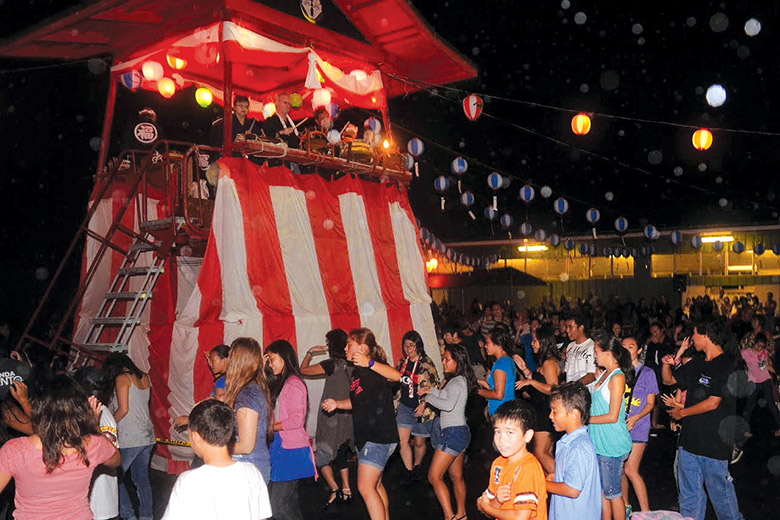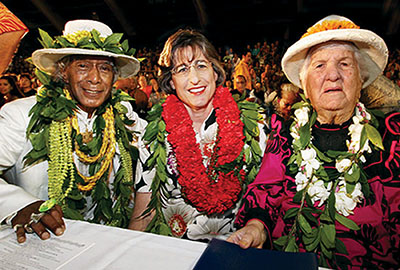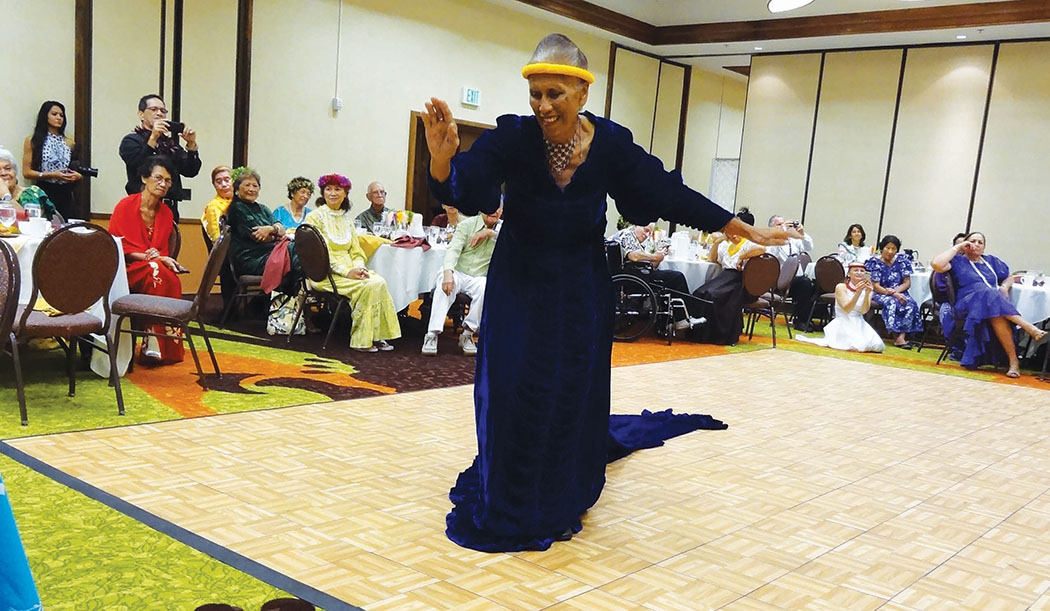
Dressing for a Holokū Ball

By Leilehua Yuen

The first three rules my Nana, my paternal grandmother, drummed into my head about looking good in a holokū were:
- Posture
- Posture
- Posture
They are still valuable rules today. Perfect posture and a sense of panache enable one to carry off virtually anything. Once they are achieved, all else is easy.
Foundation garments for a holokū follow the same rules as for other garments—well fitted so that they smooth the body, rather than add lumps and grooves—and invisible once attired. Stockings may or may not be worn.
Shoes for a holokū generally should be light and dainty, and carry the theme or era of the gown. A holokū reminiscent of the Gibson Girl look would do well with a full shoe in a soft kid or satin. If the cut is closer to WWII, then a heeled open toe slingback might work well. A 70s or even more modern look generally does nicely with dressy sandals. When ordering a custom holokū, my Nana would ask the dressmaker to have some of the fabric sent to her shoemaker to have matching shoes made.
Hair can be worn up or down. A lei po‘o (head lei) or wehi (floral hair ornament) looks well alone or in combination with a Spanish or Victorian style comb. Speaking of Victorian accessories, a réticule is the perfect handbag for a holokū, and can be made from a few scraps of fabric left from the garment. Lauhala clutches also are quite nice. And a lauhala fan can be quite useful if the evening is warm.
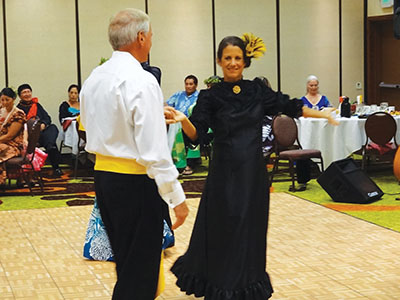
Lei, of course, are always appropriate accessories, and should compliment the cut of the gown. If the yoke is deeply ruffled, a lei that hangs just above the ruffle and echoes its shape can have a lovely effect. Pūpū o Ni‘ihau (shell), lei hulu (feather), and lei hoaka (boar’s tooth), are among the more formal lei.
If wearing floral and/or maile lei, choker length to knee length could be worn, depending on the cut of the holokū. Do use care in selecting the flowers, however. Deep colored blossoms such as Nani Ola‘a and jade vine can stain, so they should only be worn on very dark fabrics or bare skin (if one does not have a sensitivity to the blossom). If the cut of the holokū allows, wearing the lei kīkepa, over one shoulder and tied at the opposite hip, can give a lovely effect.
Once one is fully attired and ornamented, moving gracefully with a six foot train can take a little bit of thoughtfulness. Smaller steps, somewhat slowed, will allow the train to keep up with one, preventing it snagging and jerking along the floor. When turning, it helps to keep moving forward so that the train does not wrap around one’s feet, but rather makes a long sweeping arc behind.
Once the grand entry has been made, one’s escort might be gracious enough to pick up the lady’s train by its loop, and hand it to her. Then, the loop goes over the left hand, and the train may be carried for convenience. Yes, it is perfectly fine to use the left hand to make graceful gestures when talking, which just happen to show off the beauty of the train.

When being seated at a table, the train can be laid across the lap, and one’s napkin placed over it. When sitting in the ballroom or parlor, the train may be allowed to rest on the floor. It looks unlovely in a wadded pile, but, with just a little practice, one can learn to give a slight flick that lets the train settle gracefully by one’s feet.
Of course, an elegantly attired man should escort such an elegantly attired woman!
And what is more elegant than a man dressed in crisp white with a lei and a kā‘ai? It is an image to sweep a woman off her feet!
In Hawaiian dress, the kā‘ai replaces the waistcoat, providing a segue between the dress shirt and the pants, hiding the often bunchy and untidy line where the shirt is tucked in. With its broad waist and long tails, it adds visual height to a man, a slimmer appearance, and accentuates the chest. The kā‘ai is cooler to wear than a waistcoat, and for many occasions can be worn without a jacket, making it ideal in the tropics.
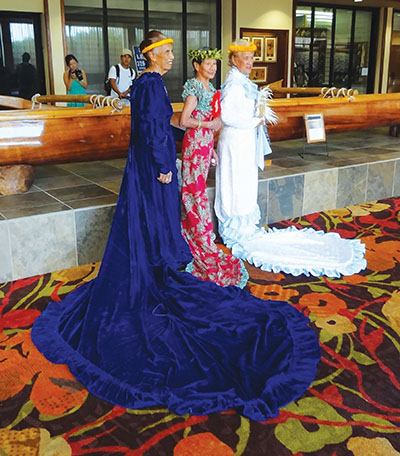
For my grandfather’s kā‘ai the dressmaker often would use the same fabric as for the holokū she was making for my grandmother. The kā‘ai should be twice the height of the gentleman, or five times the gentleman’s waist measurement, whichever is greater. If the holokū’s train is self-lined or unlined, both faces of the kā‘ai would be in the holokū fabric. If the train were lined with a contrasting fabric, then the kā‘ai would have the inner face made of that. Some of the dressier kā‘ai have fringe or tassels at the ends.
Generally the kā‘ai would be worn with the pola, the “tails,” hanging down on the left. When horses were the general transportation for people who wore such attire, one stood to the left of the horse to mount, placed the left foot in the stirrup, and swung the right leg over the horse. A sash hanging down the right leg would have presented some difficulties.
The kā‘ai should be positioned so that there is an equal amount of fabric above and below the top of the waistband of the pants. The pola should be positioned so that when one is standing erect with the arms hanging naturally at the sides, the hand is centered front-to-back on the pola.
There are various ways to wrap the kā‘ai. The most simple, and least likely to untie at awkward moments, is the knotted wrap. Place the center of the kā‘ai on the left side of the waist, bringing the fabric across the back and the abdomen. Cross the fabric over the right side of the waist, smoothing it neatly and bringing the ends back to the left. Pulling the kā‘ai snug, tie a square knot tight up against the waist. Let the rear-most pola hang, and tuck the forward pola up under the kā‘ai and bring it out over the top, pulling the knot about one third of the way up under the kā‘ai. Smooth out the under pola so that it hangs flat from the waistband. Smooth the upper pola so that it drapes flat over the waistband, and hangs on top of the lower pola. The end of the upper pola should be one or two inches above the end of the lower pola. If the pola are fringed or tasseled, the bottom edge of the fringe on the upper pola should just touch the top edge of the fringe on the bottom pola.
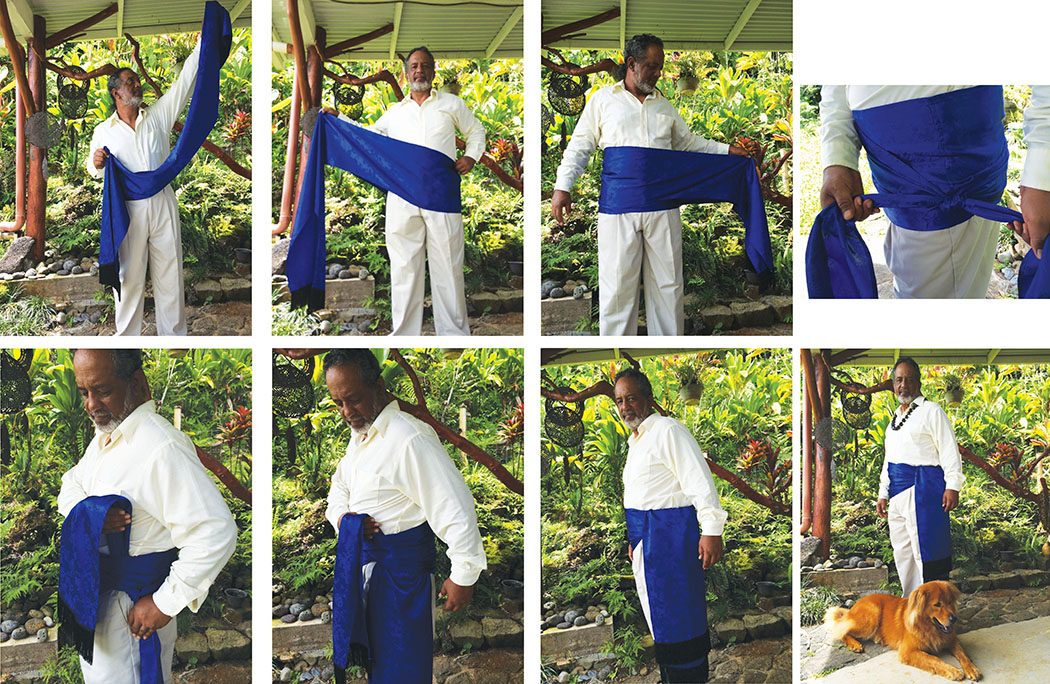
pulling it all the way through. 6) Smooth the lower pola so it lies flat to your hip and leg. 7) Smooth the upper pola; the upper pola should hang slightly higher than the lower pola. 8) Put on your lei! Kā‘ai photos by Leilehua Yuen
Attire with which the kā‘ai is worn is generally about the same as white tie or black tie, sans the waistcoat. A lei hoaka or other lei niho might be worn instead of the tie. If one elects to go open collar, then a soft fronted shirt should be selected. In any case, a mid-chest closed lei or a long open lei is ideal. When wearing a lei, there is no need for a boutonniere, pocket square, or dress scarf. ❖
Contact writer Leilehua Yuen: Leilehua@LeiManu.com
Mahalo to the Schuwer family for permission to share the memories of Aunty Maile
